Abstract
This study investigates the influence of various reinforcing fibers, including coconut, basalt, glass, merino wool, and polypropylene, on the properties and processability of cementitious mixtures, with a particular emphasis on their application in 3D printing. The incorporation of fibers at a concentration of 1 wt.% was found to significantly hinder the printing process. Specifically, certain fibers, such as polypropylene, rendered extrusion impractical due to nozzle clogging. However, reducing the fiber content to 0.5 wt.% improved material flowability and minimized structural defects during printing. Fiber selection, in addition to its impact on mechanical properties, plays a crucial role in determining overall process efficiency. Mixtures incorporating coal slag as a dense filler, combined with stiff fibers such as basalt or glass, exhibited the highest flexural strength. Moreover, the inclusion of merino wool fibers enhanced the flexural performance of fly ash-based mixtures, achieving strength levels comparable to or exceeding those of stiffer fibers. These findings contribute to the advancement of sustainable construction practices. Notably, samples produced via 3D printing consistently demonstrated higher flexural strength than those fabricated using traditional molding techniques. This enhancement is attributed to microstructural modifications induced by the layer-by-layer deposition process. Depending on the sample composition and the type of reinforcing fiber, water absorption behavior varied significantly. Merino wool and coconut fibers exhibited the highest water absorption due to their hydrophilic nature and capillary action, particularly in 3D-printed samples with open-pore structures. In contrast, glass and basalt fibers, characterized by their higher density and hydrophobicity, exhibited lower water absorption levels. These results underscore the importance of optimizing fiber type, concentration, and processing methodologies to achieve tailored performance in fiber-reinforced cementitious mixtures. Such optimizations align with the principles of sustainable development and hold significant potential for advancing 3D-printed construction applications
1. Introduction
In the traditionally conservative construction industry, interest in additive manufacturing has surged in recent years, particularly in the context of precast concrete elements. This emerging technology offers substantial advantages, including reduced order lead times, lower labor costs, and decreased reliance on conventional construction equipment. Additionally, it eliminates the need for traditional formwork systems. Extensive research efforts have been dedicated to developing materials with critical properties essential for successful 3D printing, such as fluidity, pumpability, layer buildability, and compressive strength. Collectively, these parameters constitute key criteria for evaluating materials in 3D concrete printing and significantly influence its overall success [1,2].
Despite these advancements, most existing studies have predominantly focused on homogeneous materials, with relatively limited exploration of the potential of foamed concrete and fiber-reinforced concrete for 3D printing applications. Among these, foamed concrete has emerged as a particularly promising material for additive manufacturing. Characterized by low density, excellent thermal insulation properties, and superior formability, foamed concrete typically exhibits densities ranging from 400 to 1850 kg/m3. Its low thermal conductivity and high fire resistance further enhance its appeal as a sustainable construction material. To enhance its tensile and flexural strengths and improve control over the 3D printing process, various reinforcement strategies have been investigated. Among these, the incorporation of reinforcing fibers during the mixing stage is particularly promising. Fibers can be uniformly distributed throughout the concrete matrix, thereby improving mechanical performance and addressing specific limitations. Both natural and synthetic fibers have been successfully utilized in 3D printing applications, each imparting distinct mechanical and physical characteristics to the material. The selection of fiber type is typically dictated by factors such as the intended application, required mechanical properties, cost, and material availability. Despite significant advancements in 3D printing technologies, dispersed fiber reinforcement in concrete mixtures, and the properties of foamed concrete, the specific interactions between fiber reinforcement and foamed concrete within additive manufacturing remain largely unexplored. This study addresses this critical research gap by investigating how different fiber types influence the printability, mechanical performance, and durability of 3D-printed foamed concrete. By integrating fiber reinforcement into foamed concrete, this research aims to enhance structural integrity while optimizing material properties for large-scale construction applications. The findings contribute to the broader development of 3D concrete printing technology, offering valuable insights into the feasibility and benefits of using fiber-reinforced foamed concrete as an innovative construction material. These results underscore the potential for advancing sustainable and efficient construction practices through the integration of fiber reinforcement in 3D-printed foamed concrete systems.
1.1. Fibers in 3D Printing
As 3D printing technology continues to advance, its potential to transform the construction industry is becoming increasingly evident. The ability to produce complex geometries, customize designs, and minimize material waste are among its most notable advantages. Despite these promising applications, 3D concrete printing still faces significant challenges. One of the primary concerns is ensuring the structural integrity of the lower layers during the additive manufacturing process. Precise control over the concrete mix is critical for maintaining homogeneity and consistency, as the layer-by-layer deposition characteristic of 3D printing can result in inconsistencies and weak interlayer bonding, potentially compromising the overall strength of the printed structure.
To address these challenges, exploring alternative reinforcement methods compatible with 3D printing technologies is essential for achieving the requisite strength and durability. Fiber incorporation in concrete has emerged as a promising approach to maintaining form stability during printing, contributing to more precise and accurate structures. However, fiber addition also affects the rheological properties of the concrete mix, influencing its fluidity, pumpability, and printability—particularly when small nozzle sizes are employed. Research has demonstrated that the inclusion of fibers alters extrusion dynamics and interlayer adhesion, with varying outcomes depending on fiber type, length, and concentration.
For instance, studies indicate that incorporating 0.5–1 wt.% basalt fibers can support efficient extrusion while maintaining printability [3,4,5]. Similarly, Panda et al. investigated the effects of glass fibers with lengths of 3 mm, 6 mm, and 8 mm and concentrations ranging from 0.25% to 1%. Their findings revealed that fiber contents exceeding 2% significantly increased viscosity, leading to nozzle clogging and reduced fluidity, which can negatively impact the performance of printed structures [6,7]. These insights underscore the necessity of balancing fiber content to optimize both material properties and the printing process.
The impact of different fiber types on the overall properties of 3D-printed concrete extends beyond its fluidity and remains a critical area of study. Fiber reinforcement offers the added benefit of addressing challenges associated with incorporating traditional steel reinforcements into printed elements. A diverse range of short fibers has been explored in the context of 3D concrete printing. Among these, steel fibers are the most widely studied [8]. Other fiber types, including carbon [9,10], basalt [9], glass [11,12], wollastonite [13], polyethylene (PE) [14], polypropylene (PP) [15], poly(vinyl alcohol) (PVA) [16], and polymethyl methacrylate (PMMA) [17], have also been investigated. Furthermore, researchers have analyzed recycled rubber fibers [18], natural fibers such as flax [19], jute [20], and sisal [21], as well as combinations of elastic and rigid fibers [22].
These investigations highlight the versatility of fiber reinforcement in enhancing the mechanical and structural properties of 3D-printed concrete. However, they also emphasize the need for continued research to better understand the interplay between fiber type, concentration, and the specific requirements of 3D printing. Advancing this knowledge will not only improve the performance of 3D concrete printing but also support its broader adoption as a transformative construction technology.
An effective strategy to enhance the strength of concrete mixes for 3D printing involves incorporating fibers during the raw material preparation phase. This approach ensures the uniform distribution of fibers throughout the concrete matrix, facilitating the smooth passage of short fibers through the nozzle and mitigating the risk of clogging. Fibers, particularly those oriented perpendicularly to potential crack paths, play a pivotal role in inhibiting crack initiation and propagation. This mechanism substantially enhances the tensile strength and durability of the concrete, effectively mirroring the function of traditional steel reinforcement bars in maintaining structural integrity, even in the presence of cracks [23].
Research by Shakor et al. demonstrated that the addition of 1 wt.% glass fibers significantly improved the mechanical properties of 3D-printed concrete. Specifically, compressive and flexural strengths increased by approximately 108% and 68%, respectively. The study further revealed that nearly 80% of the fibers aligned with the nozzle layering direction, underscoring the critical influence of fiber orientation on material properties [24]. Similarly, investigations into lightweight polypropylene fibers indicated that alignment in the printing direction enhances compressive strength along that axis, further supporting the importance of fiber orientation in optimizing performance [25].
1.2. Foam Concrete in 3D Printing
Numerous studies have investigated the strength properties of 3D-printed concrete, focusing on recycled materials, hybrid compositions with geopolymers, fiber-reinforced concrete, and foam concrete. Foam concrete, in particular, aligns with the growing demand for energy-efficient building materials. Its lightweight composition, excellent thermal insulation, and high fire resistance make it a promising option for sustainable construction. However, foam concrete remains underutilized in 3D printing due to two significant challenges: the preparation of the foamed mixture and its subsequent pumping.
The commercial production of foam concrete primarily employs two methods for generating technical foam: pre-foaming and mixed foaming [26,27]. The pre-foaming method involves preparing a foam solution that generates air bubbles, which are then combined with separately prepared cement mortar to achieve a homogeneous texture. In contrast, the mixed foaming method directly introduces foaming agents into the concrete mix [26,28]. The final density of foam concrete depends on several factors, including the proportions of the mix components, the water content, and the concentration of the foaming agent. Achieving an optimal surfactant concentration is critical for maintaining foam stability during the extrusion process, ensuring a consistent pore structure, and minimizing bubble collapse.
Pumping foam concrete, particularly over long distances, poses additional challenges by affecting foam stability and pore size distribution within the material [28,29,30,31]. Maintaining the appropriate consistency and ensuring the stability of printed elements are essential for successful layer deposition [29]. The fluidity of the foam concrete mix and the effects of extrusion on foam stability are recognized as primary obstacles in 3D printing applications [27]. Consequently, the optimal mixture composition must balance reliable printability with minimal risk of bubble rupture during the printing process [28].
Research by Liu et al. demonstrated that the inclusion of hydroxypropyl methylcellulose enhances the ability to build successive layers of foam concrete by promoting the formation of large flocculates that aggregate cement particles. Additionally, silica ash has been shown to improve foam stability by absorbing free water and forming flocculates between silica fume (SF) particles and between SF and cement particles, thereby restricting water movement and increasing the stability of the printed structure [32].
For optimal performance in 3D printing, the aggregate fraction diameter should be within the range of 2–4 mm, as this size ensures compatibility with the extrusion process, facilitates smooth layer deposition, and enhances precision in the printed output. The use of coarser aggregates may result in technical complications, including nozzle clogging and structural inconsistencies. To reduce weight and increase porosity in 3D-printed foam concrete elements, lightweight aggregates such as expanded perlite have been utilized [33]. In these applications, foam is typically generated by diluting a 30% concentration foaming agent with water at a 1:60 ratio. Research has demonstrated that substituting fine aggregates, such as sand, with perlite decreases the required foam content while maintaining the material’s density and improving both its fresh and hardened properties. To enhance the mechanical properties and impact resistance of foam concrete, the incorporation of reinforcing fibers has been identified as an effective approach. Dispersed fibers mitigate challenges associated with conventional steel reinforcement in 3D printing, thereby improving durability and structural integrity. The growing body of research on fiber-reinforced foam concrete highlights its potential to address these challenges, further advancing its applicability in additive manufacturing.
1.3. Fiber Reinforced Foam Structures
Fiber-reinforced foamed concrete structures represent a compelling area of materials engineering, combining the lightweight and insulating properties of foamed concrete with the enhanced mechanical performance imparted by fiber reinforcement. The incorporation of fibers into foamed concrete significantly improves its tensile and bending strengths, thereby enhancing its load-bearing capacity and resistance to dynamic loads. Despite these advantages, a considerable research gap persists regarding the adaptation of fiber-reinforced foamed concrete for 3D printing applications. Bridging this gap requires a detailed investigation of mix compositions, stability during the printing process, production methodologies, and the types of fibers used for reinforcement, along with their influence on mechanical properties and long-term durability. Addressing these challenges is crucial for advancing the use of foamed concrete in structural engineering and unlocking its full potential in additive manufacturing.
A review of existing literature highlights that the inclusion of short, dispersed fibers positively influences the mechanical properties of foamed concrete. The preparation of fiber-reinforced foamed concrete typically involves mixing the fibers with cement mortar before the introduction of foam. Fibers can be added either to the dry ingredients or to the pre-mixed cement mortar to ensure uniform dispersion. For example, Li et al. developed a process to prevent fiber clumping by mixing cement and basalt fibers in a drum for two minutes, adding two-thirds of the water for one minute, and then the remaining water for an additional five minutes before incorporating the pre-foamed mixture and stirring for five minutes at 100 rpm [34]. Similarly, Lei et al. and Wang et al. employed methods in which cement and water were mixed at ratios of 0.4 and 0.6, respectively, before adding fibers and mixing for uniform distribution. Foam was then introduced, with its volume carefully controlled to achieve the desired density [35].
Experimental studies have further demonstrated the efficacy of various fiber types in enhancing the mechanical properties of foamed concrete. For instance, Awang et al. found that adding 0.4% (by volume) of polypropylene (PP) fibers increased compressive strength by 35% [36]. Similarly, incorporating 1.5% carbon fibers improved compressive strength by 36%, with the combination of PP fibers yielding even greater enhancements [37]. Zheng et al. investigated poly(vinyl alcohol) (PVA) fibers, PP fibers, and recycled fibers from damaged wind turbine blades (comprising glass fibers and resin). Their findings revealed that 0.25% PVA fibers increased compressive strength to 1.50 MPa, whereas excessive PP fiber content led to agglomeration, negatively impacting strength. Recycled fibers improved strength to a lesser extent due to their larger diameter and uneven dispersion, which reduced their reinforcing effectiveness [38].
Despite these challenges, fiber reinforcement in foamed concrete mitigates key limitations, such as reducing the number and size of pores. However, excessive fiber content may puncture air bubbles during mixing, compromising foam stability [39]. Additional studies have indicated that incorporating basalt fibers and marble powder enhances the physico-mechanical properties of foamed concrete while reducing drying shrinkage [40,41].
Foamed concrete, a cement mortar mixed with a foaming agent, offers significant advantages due to its reduced density and high thermal efficiency. However, its application in 3D printing is often constrained by structural deformations in the lower layers caused by the weight of successive layers. Fiber reinforcement has been shown to enhance the stability of foamed concrete during the printing process by mitigating cracking and distortion, improving surface quality, and minimizing material settlement. Despite these benefits, research on fiber-reinforced foamed concrete specifically tailored for 3D printing remains limited, leaving critical gaps in understanding its behavior under additive manufacturing conditions.
Addressing these gaps is essential for advancing 3D printing technologies in construction, particularly given the increasing demand for sustainable and efficient building materials. A more comprehensive investigation into the interaction between dispersed fibers and foamed concrete during the printing process could help overcome existing technical limitations and expand the potential of this composite material. This study aims to address these challenges by systematically analyzing the mechanical properties, microstructural behavior, and printability of fiber-reinforced foamed concrete, contributing to the broader development of innovative construction methodologies.
The distinct contribution of this research lies in its holistic approach, integrating foamed concrete, dispersed fiber reinforcement, and 3D printing—an area that has not been extensively explored in the literature. Unlike previous studies, which have primarily focused on either fiber-reinforced solid concrete in 3D printing, foamed concrete printed without fiber reinforcement, or fiber-reinforced foamed concrete fabricated through traditional casting, this study examines all three aspects within a unified framework. By evaluating the influence of different fiber types on both the mechanical properties and microstructure of 3D-printed foamed concrete, this research provides new insights into optimizing fiber-reinforced foamed concrete for scalable, real-world construction applications.
The integration of 3D printing technology with foamed concrete incorporating recycled materials and reinforcing fibers corresponds with the broader objective of reducing dependency on natural resources within the construction industry. Simultaneously, the growing implementation of automation in construction emerges as a response to the increasing demand for faster, more efficient project execution, while concurrently improving quality, safety, and reducing both time and cost of delivery [42,43]. Innovation in this domain is intrinsically driven by technological progress, which continues to redefine traditional construction methodologies. These advancements compel construction enterprises to adopt forward-looking strategies that are responsive to both their technological potential and the rapidly evolving market dynamics [44].
Strategic implementation of innovations such as 3D concrete printing necessitates a strong orientation toward end-user requirements and detailed demand analysis. As such, the incorporation of advanced technologies into long-term development frameworks has become essential for sustaining competitive advantage. A key determinant of success in this context is the ability to translate domain knowledge and expertise into disruptive solutions that address critical challenges facing the contemporary construction sector.
A quantitative evaluation of the impact of concrete mix design technologies on project outcomes requires a systematic assessment of the effects of fiber reinforcement and 3D printing processes on principal performance indicators. The research presented herein provides empirical data on the properties of foamed concrete reinforced with various fiber types and examines their influence on the material’s printability. Essential parameters for evaluating preparation technologies include the type and dosage of reinforcing fibers. This study investigates the incorporation of basalt, coconut, glass, polypropylene, and merino wool fibers at dosages of 1 wt.% and 0.5 wt.%, respectively. Additionally, mixing and foaming parameters—such as foam density, bubble size distribution, and long-term foam stability—play a critical role in determining the uniformity of the mix and its suitability for 3D printing applications. Automation of these processes, particularly through precision dosing systems, significantly enhances control over mixture variables and contributes to improved material performance [45].
With respect to digital integration and process automation, this study highlights the optimization of the extrusion phase. Automated systems that dynamically regulate printing parameters in response to real-time input variables—such as viscosity and temperature—are pivotal for ensuring consistency and minimizing defects in printed elements. From the perspective of project development, performance metrics such as flexural strength and structural integrity are of paramount importance. Process automation during the material preparation phase, particularly in optimizing fiber dispersion and mixing homogeneity, directly correlates with improved mechanical and structural characteristics of the printed components [46]. Additional critical metrics include water absorption capacity and long-term durability, as these parameters significantly affect the performance of concrete in varying environmental conditions.
Printability and buildability also constitute essential performance criteria. Optimization of fiber content and refinement of the mixing methodology enhance the extrudability and buildability of the mix, facilitating more efficient construction, reduced project timelines, and improved construction precision. This, in turn, contributes to enhanced overall productivity. Furthermore, higher levels of automation, particularly in the mixing and foam generation stages, are associated with reduced preparation times and greater consistency in printed components. Optimizing fiber reinforcement not only enhances structural strength and reduces porosity but also improves durability, offering long-term benefits such as lower maintenance requirements and enhanced performance across a range of operational conditions.
2. Materials and Methods
2.1. Materials
The mixture was prepared using sand with a particle size distribution of 0.5 to 1.4 mm and CEM IV 42.5 cement, known for its reduced CO2 emissions, supplied by Lafarge Polska (Holcim Group, Małogoszcz Cement Plant, Małgoszcz, Poland). The CEM IV/B (V) 42.5 N—LH/NA cement is a pozzolanic cement classified under PN-EN 197-1 [47], characterized by a compressive strength of ≥42.5 MPa after 28 days, low heat of hydration (LH), and reduced alkali content (NA). The initial setting time is ≥75 min, while the expansion in the Le Chatelier test does not exceed 10 mm. The pH of a cement–water mixture (1:2 ratio, 20 °C) ranges between 11 and 13.5. The cement’s density falls within 2.75–3.20 g/cm3, with a bulk density of 0.9–1.5 g/cm3. The soluble hexavalent chromium content remains below 2 mg/kg, adhering to regulatory requirements. The material exhibits low solubility in water (0.1–1.5 g/L) and a particle size distribution between 5 and 100 µm. Due to its limited alkali content (Na2Oeq ≤ 0.6%), it effectively mitigates the risk of alkali-silica reaction, making it particularly suitable for durable concrete applications [48]. To enhance sustainability, 5% of the cement content was substituted with fly ash sourced from the Kraków CHP Plant (PGE Energia Ciepła S.A., Kraków, Poland), while 20% of the aggregate was replaced with slag obtained from the Puchaczów power plant (Łęczyńska Energetyka Spółka z o.o., Puchaczów, Poland) (Table 1).

Table 1.
Chemical composition of the raw materials.
The prepared mixtures were reinforced with various fibers, including coconut, basalt, glass, merino wool, and polypropylene, incorporated at dosages of 1% and 0.5% by weight, as detailed in Table 2 and illustrated in Figure 1. The selection of fiber contents (1 wt.% and 0.5 wt.%) was based on an extensive literature review described above, aiming to examine the highest feasible concentrations that could be practically applied in large-scale 3D printing for construction purposes. Since the ultimate objective of this research is to develop a material suitable for real-world construction applications under varying environmental conditions, these values were chosen to assess the performance of foamed concrete reinforced with dispersed fibers at extreme concentration levels. The choice of fiber types—basalt, coconut, glass, polypropylene, and merino wool—was guided by their distinct mechanical properties, durability, and potential benefits in both structural and insulating applications. Basalt fibers, known for their high tensile strength and chemical resistance, enhance crack resistance and overall durability in foamed concrete. Coconut fibers, as a sustainable and flexible natural alternative, provide good water resistance, impact resistance, and energy absorption, making them particularly useful in lightweight and insulating applications. Glass fibers improve tensile strength and minimize shrinkage cracking, enhancing the structural stability of foamed concrete, especially in load-bearing applications. Polypropylene fibers contribute to ductility, toughness, and resistance to plastic shrinkage cracking, making them well suited for lightweight reinforcement. Merino wool fibers, a bio-based material with excellent thermal and acoustic insulation properties, offer potential for improving the energy efficiency of non-load-bearing construction elements. By investigating this diverse selection of fibers, this study aimed to identify the most effective reinforcement strategies for 3D-printed foamed concrete, balancing mechanical performance with insulation properties to optimize its application in large-scale construction.

Table 2.
Fibers characteristics.
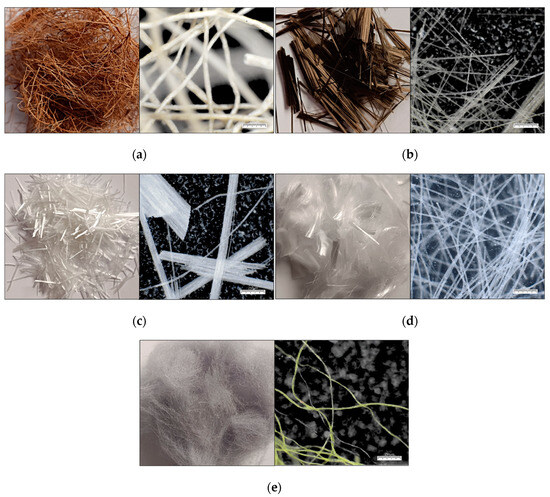
Figure 1.
Representative view of (a) coconut (CO) fibers, (b) basalt (B) fibers, (c) glass (G) fibers, (d) polypropylene (PP) fibers, and (e) merino wool (M) fibers.
Foaming of the mixtures was achieved using a synthetic foaming agent, Pianotwor, mixed in a 1:1 ratio (Table 3). A total of 24 distinct mixtures were formulated, including reference samples that excluded fiber reinforcement.

Table 3.
Data from the product specification sheet of the foaming agent manufacturer.
The specific compositions and proportions of all mixtures are outlined in Table 4. The water-to-cement (w/c) ratio was maintained between 0.24 and 0.27, depending on the mixture composition. This range was selected to ensure consistency and optimize the mechanical properties of the foamed concrete. A mixing station aligned with the idea developed as part of the “Implementation doctorate” was used to blend the material.

Table 4.
Designation and compositions of investigated mixtures.
2.2. Designing the Mixtures
To enhance the efficiency and economic viability of composite concrete, researchers have explored the incorporation of various additives and substitutes, including fly ash, silica fume, superplasticizers, fibers, and other materials. Despite these advancements, no universally accepted method exists for determining the optimal mixing proportions. However, Kearley proposed the target density method for calculating these proportions, a technique that has since been adopted in subsequent studies [49].
Drawing on the available literature, a procedure for preparing foamed concrete mixtures (illustrated in Figure 2) has been developed. This procedure encompasses essential stages for the production, evaluation, and testing of foamed concrete, with a particular focus on assessing its stability and performance. The process begins with the blending of dry ingredients, including reinforcing fibers incorporated to enhance the mechanical properties of the concrete. Concurrently, a stable foam is generated, characterized by a uniform bubble structure. Key parameters such as foam density, bubble size distribution, and long-term stability are systematically monitored during this phase. Once both the concrete mixture and foam are prepared, they are combined under controlled conditions to ensure homogeneity, a methodology conceptualized within the framework of the “Implementation Doctorate” project. Following the integration of components, a stability assessment is conducted to evaluate the uniform distribution of foam within the concrete matrix. Stability is considered adequate if the foam remains evenly dispersed, without signs of sagging or delamination, and if the results of the flow table test confirm a homogeneous mixture. Should the stability criteria not be met, adjustments are made to the mixing procedure or foam parameters, and the integration process is repeated.
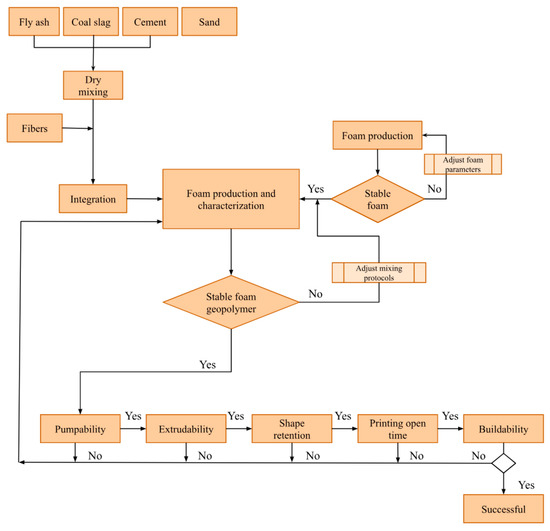
Figure 2.
Procedure flow chart of a fiber-reinforced foamed concrete preparation for 3D printing applications [50].
Upon achieving a stable foamed concrete mixture, test prints are conducted to assess its suitability for 3D printing. These tests evaluate extrudability, ensuring that the material retains its shape upon deposition without delamination or deformation. Further assessments determine whether the printed material maintains its intended geometry after application, exhibiting minimal settling or distortion.
Additionally, the workability time—the duration for which the material remains usable after production and before hardening begins—is measured. The final evaluation involves assessing the buildability of the foamed concrete, defined as its capacity to form stable and durable structures.
This comprehensive methodology provides a structured framework for producing and optimizing foamed concrete, particularly for applications in advanced construction technologies such as 3D printing.
2.3. Methods
2.3.1. Flow Table Test
The fluidity of the fresh mortar was assessed according to the PN-EN 1015-3 standard [51].
2.3.2. Stability and Buildability Assessment of Stability and Buildability
Printability tests were conducted using the gantry-style 3D printer shown in Figure 3. The printer featured a print volume of 1000 mm (X-axis), 500 mm (Y-axis), and 500 mm (Z-axis), with a print head capable of achieving a maximum speed of 80 mm/s. The experimental setup incorporated a print head equipped with a 20 L hopper and a screw feeder with a length-to-diameter ratio of 3.5, ensuring consistent material flow during extrusion.
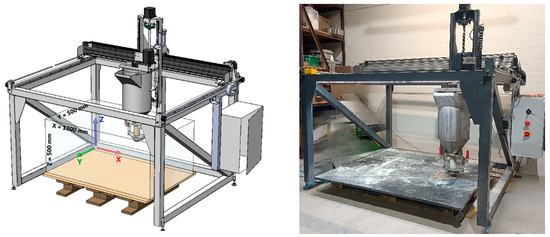
Figure 3.
Three-axis gantry-based 3D printing system.
Material extrusion was carried out using a nozzle with a diameter of 20 mm. The printed layers were set at a height of 8 mm, with a line width of 20 mm. For comparative analysis, foamed concrete was also cast in rectangular molds measuring 40 × 40 × 160 mm. The printing speed during the experiments was maintained at 40 mm/s, with a material extrusion rate of approximately 6400 mm3/s.
Each material sample was printed in two parallel lines over five layers, forming structures measuring 40 × 40 × 480 mm. After hardening, the printed samples were cut to size for direct comparison with the cast specimens. This approach enabled a thorough evaluation of the printability and material properties under both printing and casting conditions. To ensure reproducibility and validity of the results, three specimens were prepared for each formulation. The quality control process during printing involved continuous monitoring via a camera positioned in the corner of the printing area, complemented by visual inspection of each deposited layer. The consistency of the printing process was also evaluated based on the uniformity of layer deposition, the stability of the extruded material, and the adhesion between printed layers. Any visible defects, such as excessive deformation, uneven layer distribution, or printing discontinuities, were documented and analyzed. During the experiments, several process variations were considered to evaluate the robustness of the 3D printing method. One of the key challenges encountered was nozzle blockage, which occurred predominantly in formulations containing 1 wt.% polypropylene fibers and rigid coconut fibers. These blockages were attributed to fiber entanglement within the extrusion system, necessitating multiple printing attempts to achieve successful specimens. To mitigate this issue, adjustments in material preparation and feeding consistency were made, including optimizing the fiber dispersion within the mixture before extrusion. Furthermore, to maintain uniform material properties, each formulation underwent a rheological evaluation using the flow table test prior to printing. This ensured that all mixtures exhibited comparable workability, preventing inconsistencies in the extrusion process. The ambient conditions during printing, such as temperature and humidity, were also recorded, as these factors can influence the setting behavior and final mechanical properties of foamed concrete. These measures ensured the reliability and comparability of the printed and cast specimens, allowing for an accurate assessment of mechanical performance across production methods. The comprehensive documentation of printing parameters, process challenges, and quality control strategies contributes to the reproducibility of this study, providing a valuable reference for further advancements in 3D-printed fiber-reinforced foamed concrete. The assessment of concrete extrusion efficiency utilizing the aforementioned printer has been extensively discussed in the authors’ prior research [52].
2.3.3. Flexural Strength Test Flexural Strength Testing Procedure
Mechanical strength tests were performed using the MTS Criterion 43 testing machine (Eden Prairie, MI, USA) in conjunction with the MTS TestSuite 1.0 software. The specimens used for testing measured 40 × 40 × 160 mm. Flexural strength tests were conducted in accordance with the EN 13892-2:2004 standard, utilizing a testing speed of 5 mm/min to ensure consistency and adherence to standardized procedures [53].
2.3.4. Apparent Density Apparent Density Determination
The printed samples were cured under ambient conditions at a temperature of 22 ± 2 °C and a relative humidity of 55% to replicate typical construction site conditions. After 7, 14, and 28 days, the external dimensions (height and diameter) and weight of the samples were measured to calculate their apparent density prior to conducting compressive strength tests. Bulk density, defined as the ratio of the material’s mass to its total volume (including pores), was determined using the following Formula (1):
where m—samples mass, and V—samples volume.
2.3.5. Water Absorption Water Absorption Measurement
To evaluate the capillary water absorption of foamed concrete samples, specimens were placed in water-filled containers supported by plastic grids to ensure they remained elevated above the container’s base. This setup restricted the water-absorbing surface to the base of the sample, with an area of 40 mm2. The samples, fabricated using both 3D printing and conventional casting methods, were standardized to the dimensions of 40 × 40 × 160 mm. During the initial rapid absorption phase, measurements were recorded at regular intervals over a 7-day period. The absorption process was monitored by periodically weighing the specimens using a high-precision scale with a sensitivity of 0.01 g, enabling accurate tracking of mass variations. The water depth was consistently maintained at 3 mm throughout the experiment to ensure uniform testing conditions. The experimental procedure was conducted in both vertical and horizontal orientations. In the vertical orientation, standard protocols were followed to measure capillary water absorption along the sample’s height. Conversely, the horizontal orientation was employed to investigate potential variations in water absorption across the layers of the 3D-printed samples. This approach is particularly relevant as the layer-by-layer deposition process inherent to 3D printing can introduce structural inhomogeneities that may influence the material’s water absorption behavior. Following data collection, the water absorption coefficient (A) for each sample was determined based on the linear relationship between the increase in mass and the square root of time. The water absorption coefficient was calculated using the following Formula (2):
where
A—water sorption coefficient, (kg/(m2h1/2));
Δmt—sample mass increase, (kg);
F—suction surface, (m2);
Δ√t—time square root increase, (h1/2).
The observed linear relationship between the increase in mass and the square root of time enabled the calculation of the absorption coefficient for each sample, providing a precise quantification of its capillary water absorption properties.
2.3.6. Microscopy Observation
Microscopic analysis was performed using a Techrebal Banito B2920 digital microscope (Techrebal, Wilczyce, Poland) equipped with 100× magnification and a built-in 48 MP camera. This analysis aimed to evaluate the pore architecture of the foamed composites, focusing on the influence of the foaming agent and fabrication technique (3D printing versus conventional casting) on pore geometry, size distribution, and packing density. The micrographs obtained were processed and analyzed using Fiji ImageJ software Version 1.54 to enable a detailed quantitative assessment. This systematic approach provided valuable insights into the effects of production methods on the structural properties of fiber-reinforced foamed concrete. Moreover, understanding the type and distribution of fibers within the composite is critical, as these factors significantly impact the material’s mechanical properties, durability, and overall performance in construction applications.
3. Results and Discussions
3.1. Consistency and Flow Table Test
The consistency, stability, and buildability of the mixture are critical parameters in the 3D printing process, particularly when utilizing foamed fiber-reinforced concrete. Stability ensures that the mixture retains its shape following the application of successive layers, while buildability refers to the material’s ability to maintain its geometry without deformation or settling during the printing process. This section analyzes the macroscopic changes in the structure of foamed fiber-reinforced concrete through macro-photographic observations taken at various time intervals after mixture preparation. These observations provide valuable insights into the influence of time on the material’s stability and formability under conditions representative of large-scale 3D printing. Such findings are instrumental in optimizing the mixture composition to achieve the desired performance for automated construction processes. Using the developed mixture design scheme, all mixtures were prepared, with a portion cast into molds for comparative analysis of flexural strength, while the remainder was subjected to 3D printing trials. Following preparation, the mixtures underwent flow table consistency tests conducted at three intervals: immediately after preparation, 20 min after preparation, and 40 min after preparation. The flow test results, obtained in accordance with the PN-EN 1015-3 standard, are summarized in Table 5. In cases where the mixture exhibited suitable consistency immediately after preparation, subsequent flow measurements were omitted, and the material was directly used in the extrusion process. Conversely, when the flow was excessively high, the mixture was allowed to stabilize until the appropriate consistency was achieved before proceeding with printing. The tests revealed significant differences in water demand between various materials, such as slag and fly ash. Similar variations were observed depending on the amount of foam incorporated into the mixtures.

Table 5.
Flow characteristics of 24 mixtures as a function of time after mixing, evaluated in accordance with the PN-EN 1015-3 standard.
The results of the flow table test, conducted in accordance with the PN-EN 1015-3 standard, demonstrated a gradual decrease in flow diameter over time after the preparation of the mixture. This phenomenon was particularly pronounced in fiber-free mixtures, indicating a reduction in fluidity as time progressed. The type of additive used also significantly influenced the flow characteristics. Mixtures containing fly ash (FA) exhibited higher flow values compared to those incorporating bottom slag (SL), with the latter showing a stronger tendency to limit flow. This behavior can be attributed to differences in density and water absorption properties between fly ash and bottom slag. The incorporation of fibers into the mixtures notably reduced their flowability. The lowest flow diameter values were observed in mixtures containing polypropylene (PP) fibers, particularly at a concentration of 1% by weight. For instance, the B1/FA/PP1 sample exhibited a flow diameter of only 155 mm, the lowest recorded among all tested samples. A lower fiber concentration (0.5% by weight) improved the flowability of the mixture; however, the flow values remained significantly lower than those of the fiber-free mixtures. Mixtures with excessively high flow, such as B1/FA and B1/SL at the initial stage, required a waiting period of 20–40 min before printing could commence, allowing the mixture’s consistency to stabilize. In contrast, mixtures containing fibers, due to their more compact structure, required less waiting time, although their reduced flowability often hindered the proper extrusion process.
3.2. Stability and Buildability
A portion of the prepared material was cast into molds, while the remaining portion was subjected to extrusion. All samples of fiber-reinforced foamed concrete were printed under standardized conditions, utilizing identical printing parameters. During the experiment, issues related to material blockage in the screw feeder were encountered, particularly in samples containing 1% by weight of fibers. This phenomenon has also been reported by other researchers [54]. To confirm the reproducibility of this issue, certain tests were repeated multiple times to assess whether screw and nozzle clogging persisted for specific mixtures. For mixtures containing 1% by weight of polypropylene fibers, the printing process proved to be unfeasible. Similarly, for the sample containing fly ash and 1% by weight of merino wool fibers, successful printing occurred only once, despite multiple attempts. In contrast, the extrusion of foamed concrete mixtures without fibers proceeded without incident, indicating a higher degree of stability in the absence of dispersed reinforcement. Mixtures without fibers exhibited higher flow properties, requiring a waiting period of 20 to 40 min before extrusion could commence, depending on the composition of the mixture. Figure 4, Figure 5, Figure 6, Figure 7, Figure 8 and Figure 9 provide a representative view of the printed material layers depending on their composition. Both during the printing process and after curing, it was evident that mixtures containing 1% fiber exhibited greater deformation compared to those with 0.5% fiber content. Notably, significant deformation was also observed in the lower layers across nearly all tests. Structural irregularities during layer deposition are indicated by arrows, while deformations in the lower layers are highlighted by circles. These observations are consistent with the results of previous experiments conducted by the authors [55,56].
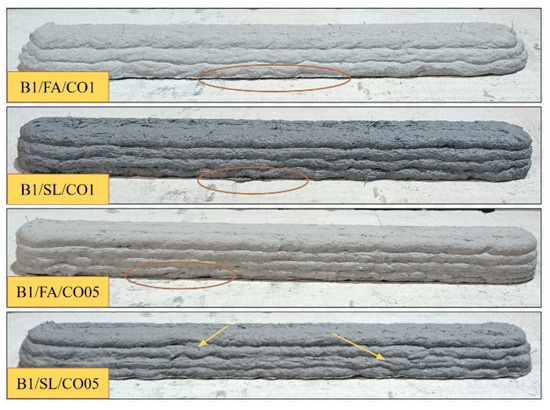
Figure 4.
Printed samples reinforced with coconut fibers.
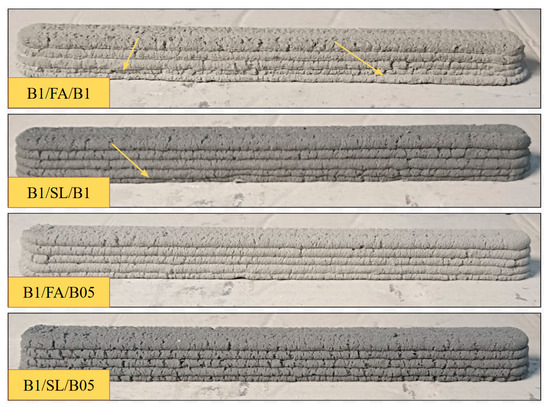
Figure 5.
Printed samples reinforced with basalt fibers.
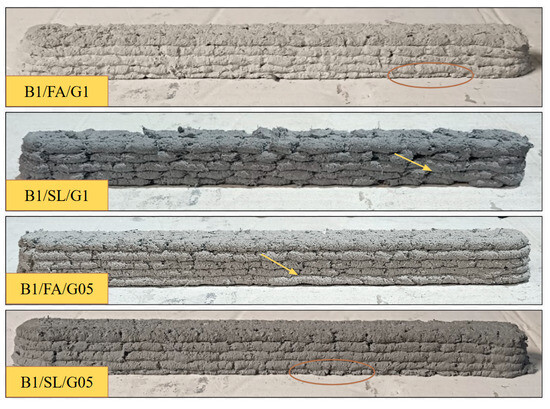
Figure 6.
Printed samples reinforced with glass fibers.
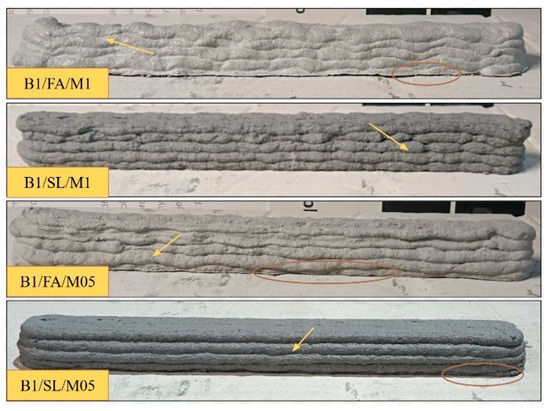
Figure 7.
Printed samples reinforced with merino wool fibers.
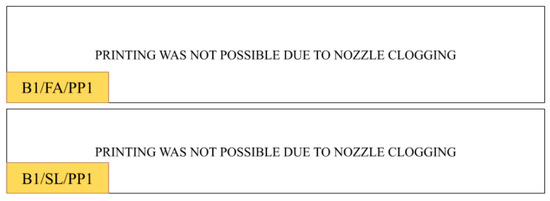
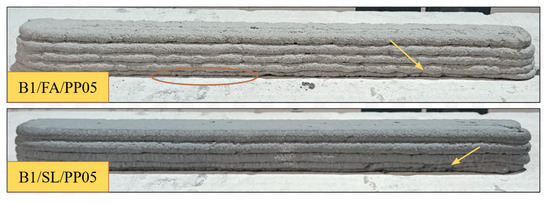
Figure 8.
Printed samples reinforced with polypropylene fibers.
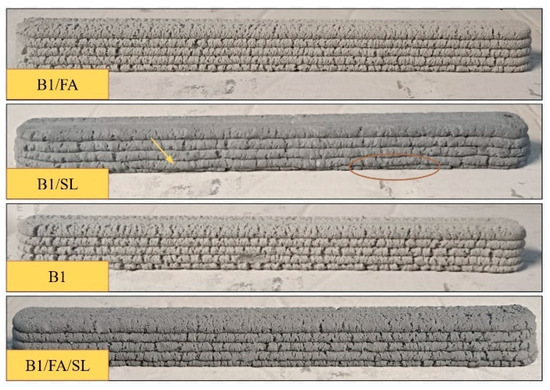
Figure 9.
Printed samples without fibers.
Samples reinforced with coconut fibers (Figure 4) exhibited significant surface roughness and pronounced irregularities in the printed layers. This effect was further amplified at a higher fiber content (1%). These observations can be attributed to the inherent stiffness and larger diameter of coconut fibers compared to other fiber types, which hinder their homogeneous integration into the concrete matrix. Consequently, the flowability of the mixture during the printing process was adversely affected, leading to disruptions in the layering process and increased uncontrolled material flow. In contrast, basalt fiber-reinforced samples (Figure 5) displayed improved cohesion between layers relative to those containing natural fibers. The surface quality of these samples was relatively smooth, with fewer pronounced irregularities. At a lower fiber concentration (0.5%), the printed layers were notably more uniform, indicating better compatibility of basalt fibers with the concrete mixture in the context of extrusion-based printing. Samples containing glass fibers (Figure 6) demonstrated well-defined layering and a relatively stable structural profile. However, at a higher fiber content (1%), localized surface irregularities and rippling were observed, suggesting challenges in maintaining consistent material flow during extrusion. Nevertheless, the incorporation of glass fibers appeared to improve the overall stability of the printed layers, contributing to enhanced cohesion compared to natural fiber-reinforced samples. Specimens reinforced with merino wool fibers (Figure 7) exhibited considerable surface irregularities, particularly at the higher fiber concentration (1%). These fibers introduced localized disruptions during the printing process, frequently causing nozzle blockages and leading to uneven stacking of the layers. At the lower fiber concentration (0.5%), the printed structures were slightly more uniform, though rippling effects remained evident. Samples containing polypropylene (PP) fibers (Figure 8) could only be successfully printed at the lower fiber concentration (0.5%), as mixtures with 1% fiber content led to frequent nozzle clogging, preventing extrusion. Despite this limitation, the samples with 0.5% PP fibers exhibited the highest degree of surface smoothness and uniformity among all the reinforced samples analyzed, aligning with results from previous research conducted by the authors [56]. Control samples without fibers (Figure 9) served as a baseline for comparison. These specimens exhibited the smoothest surfaces and the most uniform layer structures among all tested samples, underscoring the impact of fiber reinforcement on the printability and surface quality of foamed concrete mixtures. The variations in printability and structural stability of the fiber-reinforced foamed concrete samples can be attributed to the specific type of supplementary cementitious materials employed, namely fly ash and coal slag. Fly ash, characterized by its finer particle size and higher pozzolanic reactivity, enhanced the workability and cohesion of the concrete mix, a phenomenon particularly pronounced in samples with a lower fiber content (0.5%). This improved rheology facilitated a more uniform extrusion process and mitigated the occurrence of nozzle clogging compared to mixtures incorporating coal slag. Conversely, coal slag, due to its coarser granulometry and diminished pozzolanic activity, contributed to increased viscosity and reduced flowability of the material. This effect was further exacerbated in fiber-reinforced mixtures, where fiber entanglement impeded particle mobility, thereby increasing the propensity for material blockage within the screw feeder. Additionally, the presence of unburnt carbon residues in the slag may have induced inconsistencies in foam stability, adversely affecting layer uniformity during the printing process. These findings align with previous research highlighting the pivotal role of supplementary cementitious materials in governing the rheological properties of 3D-printable foamed concrete. The results indicate that fly ash-based mixtures provide a more conducive matrix for fiber dispersion and extrusion, whereas coal slag-based compositions present greater challenges, particularly at elevated fiber concentrations. This distinction is instrumental in elucidating the observed variations in structural integrity, surface quality, and deformation patterns across different sample compositions. Furthermore, a comprehensive understanding of the interaction between these additives and the selected fibers during the printing process enabled the formulation of an optimized mixture incorporating both materials in precisely controlled proportions to achieve the desired performance characteristics.
3.3. Flexural Strength Test
Figure 10 shows a comparison of the flexural strength of printed and molded samples.
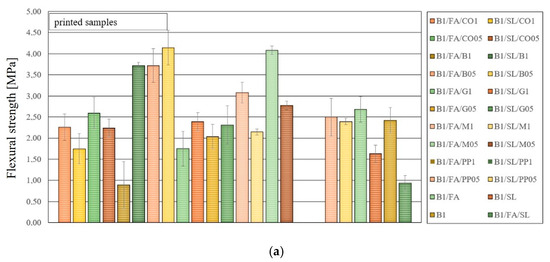
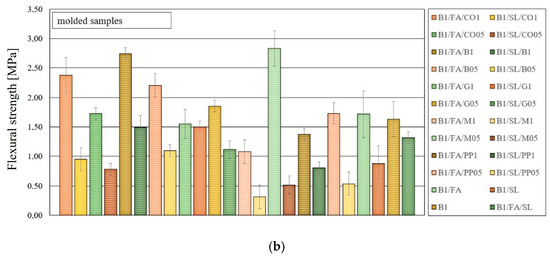
Figure 10.
Flexural strength after 28 days: (a)—printed samples, (b)—molded samples.
Flexural strength tests conducted after 28 days revealed that mixtures incorporating bottom slag (SL) in combination with basalt or glass fibers exhibited the highest flexural strength values. These results underscore the reinforcing potential of rigid fibers when utilized in conjunction with dense fillers. For instance, the B1/SL/B1 mixture achieved a flexural strength of 3.72 MPa, while B1/SL/B05 reached 4.14 MPa. Similarly, mixtures reinforced with glass fibers, such as B1/SL/G1 and B1/SL/G05, attained flexural strength values of 2.39 MPa and 2.31 MPa, respectively. Coconut (CO) and glass (G) fibers demonstrated moderate to high flexural strength, reflecting their crack-bridging properties, which enhance resistance to bending stresses. The mixture containing fly ash reinforced with merino wool fibers (B1/FA/M05) exhibited high flexural strength among the tested samples, achieving an average value of approximately 2.8 MPa for molded specimens and 4.08 MPa for printed specimens. These results are consistent with the findings of Fantilli et al. [57], who reported that the incorporation of sheep wool fibers into cementitious mortars significantly enhanced mechanical performance and sustainability by partially substituting cement with a natural, renewable additive. Specifically, the addition of 10 g (1% by volume) of untreated wool fibers, replacing an equivalent mass of cement in plain mortar, resulted in an 18% increase in flexural strength and a 110% improvement in fracture toughness. Merino wool fibers, due to their natural composition and smooth texture, positively contributed to the matrix by facilitating better interlock and force distribution within the concrete, thereby supporting the material’s mechanical integrity and compressive strength. Other fly ash-containing mixtures, such as B1/FA/B1 (reinforced with 1 wt.% basalt fibers) and B1/FA/CO05 (containing 0.5 wt.% coconut fibers), also exhibited relatively high flexural strength, exceeding 2.0 MPa. In contrast, polypropylene (PP) fibers presented significant challenges during the printing process, particularly at a concentration of 1 wt.%. Frequent nozzle clogging during extrusion hindered consistent material flow, which was primarily attributed to the physical limitations of the printing equipment rather than the intrinsic properties of polypropylene fibers. As a hydrophobic synthetic fiber, polypropylene has the potential to reduce water absorption and enhance mechanical performance when used at optimal concentrations and under suitable processing conditions. However, the challenges encountered at 1 wt.% PP highlight the importance of optimizing the printing process for fiber-reinforced mixtures to fully exploit their mechanical benefits. Furthermore, the flexural strength of printed samples was generally higher than that of molded samples across all additives, indicating the potential advantages of the 3D printing process in improving mechanical performance. In the conducted research of fiber-reinforced foamed concrete, printed samples exhibit higher flexural strength than their cast counterparts. This finding aligns with previous studies on lightweight cementitious composites reinforced with hollow glass microspheres (HGM) and polyvinyl alcohol (PVA) fibers, where the orientation of fibers perpendicular to the loading direction was found to enhance both flexural strength and overall mechanical properties, with reported increases of 8% and 40%, respectively, compared to cast samples [57]. Limited sources of research on fiber-reinforced 3D-printed foamed concrete (PVA fibers) report that cast specimens exhibited 28% (after 28 days) and 32% (after 56 days) lower strength than printed specimens when averaged across all three loading directions. This contradicts previous research suggesting that printed concrete generally exhibits lower strength than cast concrete [58]. Additionally, the flexural strength of cast-foamed concrete was lower than that of printed samples due to the denser microstructure formed during extrusion. Other studies on dense fiber-reinforced 3D-printed concrete have further highlighted the influence of fiber alignment on mechanical properties. For example, flexural strength measurements in the X, Y, and Z directions showed notable variations, with the printed samples demonstrating anisotropic behavior. The incorporation of carbon fibers in 3D-printed concrete led to significant improvements in flexural strength, particularly at a 2.5% volume fraction, due to the directional orientation of fibers induced by nozzle movement during printing. Fiber alignment along the printing path was found to increase bending strength, particularly in the Y and Z directions, enhancing mechanical anisotropy [59]. These findings indicate that, in fiber-reinforced foamed concrete, printing-induced densification and controlled fiber orientation may play a crucial role in improving flexural strength compared to cast samples. However, further investigations are required to fully understand the interplay between fiber type, orientation, and printing parameters in optimizing mechanical performance. The extrusion process was hindered by frequent nozzle clogging, which was primarily attributed to the limitations of the printing equipment rather than the inherent properties of polypropylene fibers. Despite these processing challenges, polypropylene fibers, as hydrophobic synthetic reinforcements, have the potential to reduce water absorption and improve mechanical performance when used at optimal concentrations and under controlled processing conditions. These observations underscore the importance of optimizing the printing process for fiber-reinforced mixtures to fully harness their mechanical benefits. The flexural strength of printed samples was generally higher than that of molded samples, a difference that can be largely attributed to fiber orientation and material distribution. To demonstrate this behavior, randomly selected samples are presented in Figure 11a and Figure 12a to illustrate these variations, highlighting that in printed samples, coconut and merino wool fibers tend to align parallel to the printing direction. The arrows indicate the arrangement of fibers in the printed (green arrows) and cast (orange arrows) samples. This alignment enhances structural integrity and improves flexural strength along the printing axis. In contrast, cast samples exhibit a more random fiber distribution, which can lead to localized stress concentrations and reduced mechanical performance. Furthermore, Figure 13 demonstrates the printed sample without fibers (B1/FA) shows a denser, more compact structure, whereas its cast counterpart exhibits significantly higher porosity, negatively impacting its structural integrity. These findings emphasize that fiber alignment in printed samples not only reinforces mechanical performance by improving load distribution but also mitigates the formation of structural weak points. In contrast, the uncontrolled fiber orientation in molded samples results in more heterogeneous mechanical properties and potential failure zones.
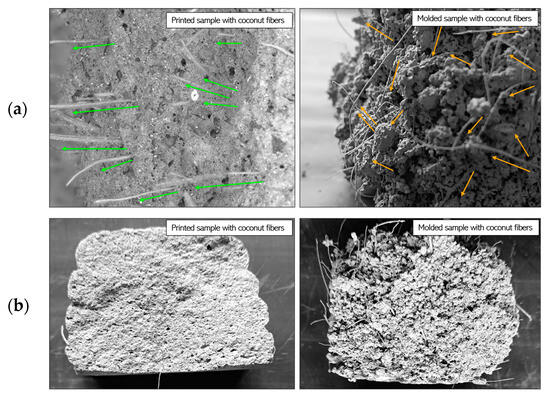
Figure 11.
Comparison of printed and cast samples containing added coconut fiber: (a) fiber arrangement in cross-section, (b) sample cross-section.
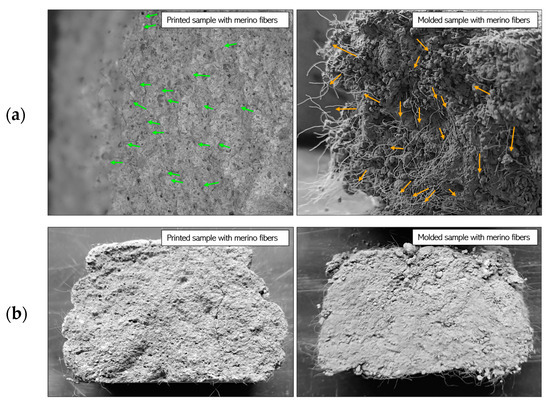
Figure 12.
Comparison of printed and cast merino fiber samples: (a) fiber arrangement in cross-section, (b) sample cross-section.
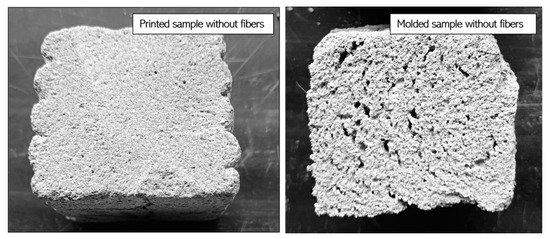
Figure 13.
Comparison of printed and cast samples without fibers: sample cross-section.
3.4. Apparent Density
Figure 14 illustrates the variation in the apparent density of the samples depending on their preparation methods.
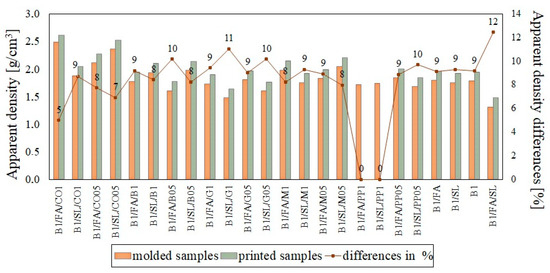
Figure 14.
Comparison of the apparent density between printed and molded samples.
Printed samples exhibited higher apparent density compared to molded samples, with differences ranging from 9% to 12%. This trend remained consistent regardless of the composition and type of reinforcing fibers used. The increased density of printed materials can be attributed to specific factors inherent to the 3D printing process. The layer-by-layer deposition characteristic of 3D printing minimizes pore formation, as the material is deposited in a controlled manner, enabling precise layer stacking and fusion. Consequently, the printed structure contains fewer internal voids compared to molded samples, where air entrapment during the molding process often leads to the formation of microscopic pores. The reduced porosity in printed samples contributes to their higher apparent density and improved material uniformity. However, inconsistencies in material flow during extrusion may lead to uneven layer deposition and localized voids. Curing conditions further amplify these density differences. Molded samples are typically cured in controlled environments, ensuring uniform hydration and solidification, which minimizes shrinkage and void formation. In contrast, printed samples, due to greater surface exposure, are prone to uneven curing, leading to micro-shrinkage and a higher void ratio. The effect of specific additives on apparent density also varies between preparation methods. Samples containing coconut fibers (CO) and glass fibers (G) show lower densities, likely due to the lightweight and porous nature of these additives, which disrupt the flow and packing of foamed concrete during printing. Polypropylene fibers (PP) have the most pronounced effect in reducing density in printed samples, likely due to their flexible and fibrous structure, which interferes with layer cohesion and exacerbates void formation. The amount of fiber additive also plays a significant role in the behavior of materials during molding and printing. At lower fiber concentrations (0.5%), the material exhibits greater cohesiveness, resulting in higher apparent density and better compaction, particularly in molded samples. For printed samples, reduced fiber content decreases the likelihood of interlayer void formation. In contrast, higher fiber concentrations (1%) introduce discontinuities into the matrix, increasing porosity and reducing density. Excessive fiber content in printed samples can hinder smooth layer deposition and bonding, leading to structural defects such as voids and weak interlayer connections. In this study, the differences in density between molded and printed samples are particularly pronounced in fiber-rich materials, such as those containing coconut fibers (CO) or polypropylene fibers (PP). To mitigate density reductions in printed samples, several optimization strategies can be employed. Adjusting printing parameters, such as reducing layer height, slowing printing speed, and increasing extrusion pressure, can improve interlayer bonding and material compactness. The introduction of chemical bonding agents or mild compaction during printing may further reduce void formation. Additionally, enhancing curing conditions through controlled humidity and temperature environments can promote uniform hydration and minimize shrinkage without compromising porosity. Microstructural analyses, such as those conducted by Sikora et al., reveal that while concrete produced via 3D printing demonstrates greater uniformity compared to traditionally molded concrete, anisotropic pores are present [60]. These pores, primarily a consequence of the layer-by-layer deposition process, are not uniformly distributed and exhibit preferential orientations. While increasing apparent density generally improves structural strength and durability, it is essential to consider the trade-off with thermal insulation. The thermal insulating properties of foamed concrete rely on its porosity, as air pockets within the material act as insulators. Therefore, optimization efforts should aim to balance structural performance with the preservation or enhancement of porosity for improved insulation. Furthermore, adjustments to printing parameters, such as reducing layer height or printing speed, should be carefully evaluated to avoid compromising the overall efficiency and productivity of the process.
3.5. Water Absorption
Water absorption tests, conducted in both vertical and horizontal orientations, relative to the printing direction, provide significant insights into the anisotropic properties of printed samples and the influence of various fibers and additives on water behavior within the concrete matrix. These observations not only highlight differences in absorption behavior but also provide clues on the underlying mechanisms driving these differences and suggest potential strategies for performance enhancement. In the vertical orientation, water absorption rates were significantly higher across all samples, regardless of the composition and type of reinforcing fibers used. Samples containing coconut fibers (CO) and glass fibers (G) exhibited the highest absorption rates, 65–70 kg/m3 after 168 h. This elevated absorption can be attributed to the fibrous nature of these additives, which increase matrix porosity and promote capillary action, thereby facilitating water ingress. Coconut fibers, being natural and highly porous, are inherently hydrophilic, making them prone to absorbing water. Glass fibers, while not hydrophilic, may create microvoids in the matrix that enhance water permeability. Additives such as polypropylene (PP) and merino wool (M) demonstrate intermediate water absorption rates. Polypropylene, a synthetic and hydrophobic fiber, contributes to absorption primarily through voids or gaps created during the printing process. Merino wool, although more hydrophilic than polypropylene, absorbs less water compared to coconut and glass fibers due to its smoother and less porous structure. The compact nature of merino wool enhances water resistance by creating a more impermeable concrete matrix. In contrast, the horizontal orientation relative to the printing direction consistently exhibits lower water absorption coefficients across all samples, with maximum values ranging between 20–25 kg/m3. This reduction highlights the anisotropy introduced by the 3D printing process. The lower absorption rates in the horizontal orientation can be attributed to stronger material compaction along the layers during printing. As the extruded material undergoes self-compaction under its own weight, fewer voids are formed, resulting in tightly bonded layers. This increased compaction also aligns with the higher density observed on the horizontal cross-section of the samples. The differences in water absorption between vertical and horizontal orientations are particularly pronounced, underscoring the role of anisotropy in printed samples. Vertical absorption is more pronounced due to weaker interlayer bonding, a characteristic feature of the layer-by-layer deposition process inherent in 3D printing. Interlayer interfaces, with their reduced adhesion, create microcracks or voids that act as capillary pathways for water ingress. In contrast, horizontal absorption benefits from stronger intralayer cohesion, as the continuous deposition within each layer promotes more uniform material bonding. Fibrous additives such as CO, G, and M further influence water absorption by introducing irregularities into the concrete matrix. These fibers disrupt the continuity of the cementitious material, increasing overall porosity and creating pathways for water penetration. Natural fibers like CO amplify this effect through direct water absorption, compounding the challenges posed by increased porosity. In printed samples, the extrusion process often exacerbates this issue, as inconsistent material distribution around fibers can further elevate porosity. The hydrophilic or hydrophobic nature of additives plays a critical role in governing water absorption. Natural fibers (e.g., CO) are highly hydrophilic and actively absorb water, whereas synthetic fibers (e.g., PP) are hydrophobic but may still increase water absorption by disrupting matrix cohesion. Process parameters during printing, including printing speed, nozzle size, and extrusion pressure, significantly influence the uniformity of material deposition. Faster printing speeds or insufficient extrusion pressure can result in incomplete filling of gaps between layers, increasing porosity and water absorption, particularly in the vertical orientation.
Figure 15 and Figure 16 present the water absorption behavior over time, analyzed in both vertical and horizontal orientations, for molded and 3D-printed samples. Molded samples exhibit generally uniform and stable water absorption patterns, characterized by lower initial absorption rates. This behavior reflects a compact and homogeneous internal structure resulting from the mold casting process, which restricts water penetration.
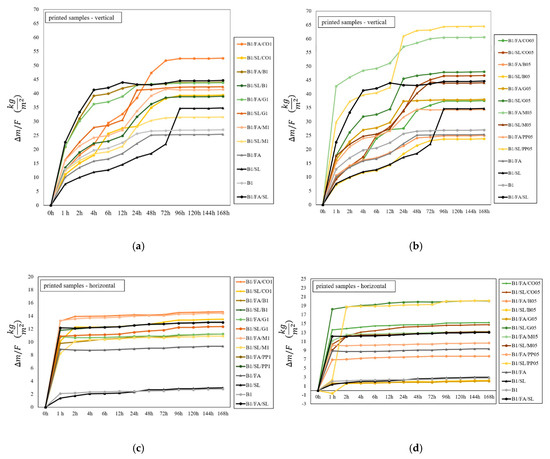
Figure 15.
The water absorption coefficient for printed samples: (a,c) samples containing 1% fiber content, (b,d) samples containing 0.5% fiber content.
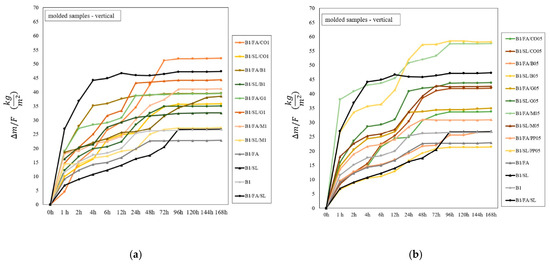
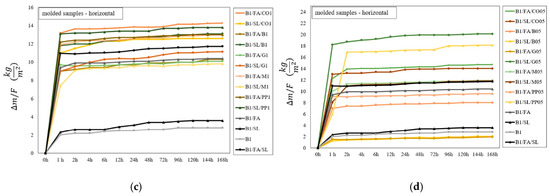
Figure 16.
The water absorption coefficient for molded samples: (a,c) samples containing 1% fiber content, (b,d) samples containing 0.5% fiber content.
In horizontal orientations, water absorption patterns are similarly stable, with smaller differences between individual samples compared to 3D-printed specimens. The latter demonstrates higher variability in water absorption, which can be attributed to imperfections in the printing process and inconsistencies in layer arrangement. Printed samples tend to absorb water more rapidly, especially during the initial testing phase. For instance, the molded B1/FA/CO1 sample in a vertical orientation records a water absorption coefficient of 4.2 kg/m2 after 1 h and 26.5 kg/m2 after 6 h. In contrast, the 3D-printed equivalent under identical conditions exhibits absorption values of 12.6 kg/m2 and 29.4 kg/m2, respectively—nearly three times faster during the initial phase.
A similar trend is observed in horizontal orientations. For example, the molded B1/FA/B1 sample absorbs 18.8 kg/m2 after 1 h, while the 3D-printed counterpart absorbs 20.9 kg/m2, representing an approximately 11% higher initial absorption. However, after extended exposure (7 days), the water absorption of molded and printed samples converges, with minimal differences. The vertical B1/FA/CO1 molded sample shows a final absorption of 52.1 kg/m2 compared to 52.6 kg/m2 for the 3D-printed sample, indicating that the total water-holding capacity of 3D-printed samples may be slightly lower due to their higher density and reduced void volume.
Both molded and printed samples display significantly lower water absorption coefficients at lower fiber concentrations (0.5%) than at higher concentrations (1%). For example, the printed vertical B1/FA/CO05 sample (0.5% coconut fibers) absorbs 9.6 kg/m2 initially, rising to 37.6 kg/m2 after 7 days. In comparison, the B1/FA/CO1 sample (1% coconut fibers) absorbs water more rapidly, with slightly higher final values. A similar pattern is evident with basalt fiber samples: the printed B1/SL/B05 sample (0.5% basalt fibers) absorbs 7.2 kg/m2 initially and 23.8 kg/m2 after 7 days, while the B1/SL/B1 sample (1% basalt fibers) absorbs 13.5 kg/m2 initially and 39.0 kg/m2 after the same period. Molded samples follow comparable trends, with final absorption values slightly lower than their printed counterparts.
Horizontal sample placement typically results in higher initial water absorption than vertical placement, regardless of the production method. Samples containing hydrophilic fibers, such as merino wool, exhibit markedly higher initial water absorption. For instance, the printed vertical B1/FA/M05 sample absorbs 42.8 kg/m2 within the first hour, significantly exceeding the B1/FA/PP05 sample (15.1 kg/m2). After 12 h, the values increase to 51.1 kg/m2 and 26.1 kg/m2, respectively. By the end of the 7-day testing period, the final absorption for the B1/FA/M05 sample reaches 60.6 kg/m2, compared to 34.4 kg/m2 for the polypropylene-reinforced sample. The higher absorption of merino wool is attributed to its natural hydrophilic properties and high capillarity, which enable rapid water uptake and retention. Conversely, synthetic fibers such as polypropylene (PP), while hydrophobic, exhibit faster initial absorption in printed samples due to the open-pore structure facilitating early water ingress.
Glass fibers, although non-porous, produce absorption values comparable to hydrophilic fibers like merino wool, indicating that they influence the pore structure in a manner conducive to water penetration. Coconut fibers, known for their porous structure, exhibit the highest water absorption across all fiber types, reinforcing their propensity for water uptake and retention over time. Fiber-free reference samples consistently display the lowest water absorption coefficients in horizontal orientations, regardless of the preparation method. This highlights the structural role of additives in water absorption behavior. Materials with larger pores typically absorb water more rapidly due to reduced capillary resistance but exhibit lower overall water-holding capacity because of limited structural volume for retention. Conversely, materials with smaller pores absorb water more slowly due to higher capillary forces but can retain larger volumes over time, owing to their denser pore network.
The water absorption behavior demonstrates no direct correlation between the rate of absorption and the total absorption coefficient. For example, materials with larger suction surfaces (e.g., horizontally oriented samples) exhibit faster initial absorption but may reach a lower total capacity. Conversely, materials with smaller suction surfaces absorb water more gradually but retain greater volumes over time. The open-pore structure characteristic of 3D-printed samples accelerates initial water absorption but limits total water retention. This behavior is linked to the higher density of printed samples, which, on average, is 10% greater than that of molded samples, reducing the void space available for water storage. Furthermore, the orientation of printed layers significantly influences water absorption characteristics by dictating the distribution, connectivity, and accessibility of the pore network. Vertically oriented samples, with greater exposure to open pores, facilitate faster water penetration. In contrast, the uniform structure of molded samples reduces initial absorption rates while increasing water retention capacity. Hydrophilic fibers, such as coconut and merino wool, enhance water absorption rates, particularly in printed samples where the open-pore structure facilitates rapid ingress. In contrast, hydrophobic fibers, including basalt, glass, and polypropylene, reduce water absorption rates but do not necessarily limit overall water retention.
The observed anisotropic water absorption behavior in 3D-printed samples has direct implications for the long-term durability and performance of foamed concrete structures. Higher absorption rates in the vertical orientation, particularly in fiber-reinforced mixtures, suggest an increased risk of moisture ingress along interlayer boundaries, which could accelerate degradation processes such as freeze–thaw damage, sulfate attack, or carbonation in service conditions. Conversely, the reduced absorption in the horizontal orientation indicates improved resistance to moisture-related deterioration along the printed layers, highlighting the potential for directional optimization in structural applications. Moreover, the enhanced initial absorption in printed samples compared to molded counterparts underscores the necessity of surface treatments or admixtures to mitigate early moisture penetration while preserving the material’s overall permeability for controlled drying. The differences in water retention between fiber types also suggest that hydrophilic fibers, such as coconut and merino wool, may contribute to prolonged internal moisture exposure, potentially affecting long-term mechanical performance and shrinkage behavior [61,62]. In contrast, synthetic fibers like polypropylene, despite facilitating early absorption through matrix discontinuities, may provide superior long-term moisture resistance due to their inherent hydrophobicity. These findings emphasize the need for tailored material formulations and post-processing treatments to enhance the durability of 3D-printed foamed concrete, particularly in environments prone to cyclic moisture exposure and freeze–thaw conditions.
3.6. Microscopy Observations
The microscopic images (Figure 17a–k) present cross-sectional analyses of 3D-printed foamed concrete samples reinforced with various fiber types. Sample (a) incorporates coconut fibers, a natural reinforcement material known for its high hydrophilicity and elevated lignin content, which impart flexibility, durability, and resistance to microbial decomposition. However, these fibers exhibit lower tensile and flexural strength compared to synthetic fibers. The natural surface irregularities of the coconut fibers contribute to a heterogeneous pore distribution, particularly in regions adjacent to the fibers, resulting in a non-uniform pore structure that adversely affects the mechanical performance of the material. The fracture surface of the sample (b) illustrates the spatial orientation and fiber distribution induced during the extrusion-based additive manufacturing process. Sample (c) contains basalt fibers, an inorganic reinforcement material renowned for its exceptional tensile strength, thermal stability, and low water absorption capacity. These properties promote effective fiber–matrix adhesion, thereby minimizing interfacial void formation. Consequently, the pore architecture in this sample is notably more homogeneous compared to coconut fiber-reinforced composites. The fractured image of sample (d) confirms the consistent dispersion of basalt fibers, which are observed to localize in distinct regions due to the flow dynamics of the printing process. Sample (e) incorporates glass fibers, characterized by their smooth surface texture, which reduces their potential for capillary water absorption and limits interfacial bonding with the cementitious matrix. This results in moderate flexural strength and a relatively low water absorption coefficient. The pore structure, marked by irregular geometries, correlates with these fiber–matrix interactions.
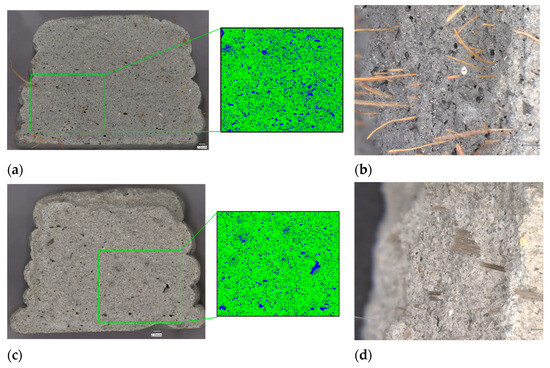
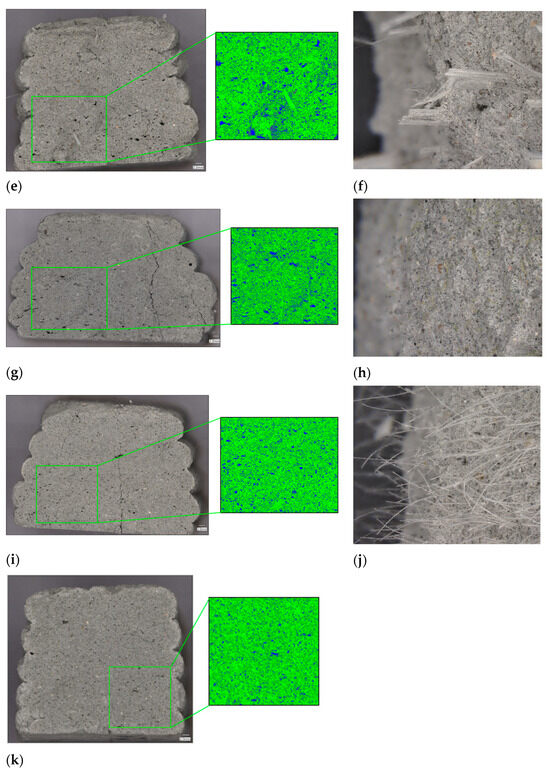
Figure 17.
Microscopic images illustrating pore size and distribution in samples with various fiber types (a,b) coconut fibers, (c,d) basalt fibers, (e,f) glass fibers, (g,h) merino fibers, (i,j) polypropylene fibers, (k) without fibers.
The fracture image (f) reveals fiber agglomeration, suggesting insufficient dispersion during mixing, likely due to the retention of the as-manufactured fiber configuration. Samples (g) and (h) contain merino wool fibers, a natural material exhibiting high hygroscopicity and low chemical affinity with the cement matrix, leading to poor interfacial adhesion. This results in elevated porosity, as evidenced by the irregular and enlarged pore morphology observed in the microscopic images. The contrast-enhanced micrograph (g) distinctly highlights the dimensions and dispersion of the merino wool fibers, while the fracture surface image (h) provides further insight into the weak bonding characteristics. Microstructural analysis confirmed that sheep wool fiber-reinforced concrete exhibited good bonding between fibers and the matrix, with low void content, supporting mechanical improvements [63,64]. Despite the high porosity, prior studies have indicated that wool fiber inclusion enhances ductility and sustainability, aligning with environmental goals by repurposing waste materials and promoting resource conservation. Sample (i), reinforced with polypropylene (PP) fibers, exhibits a pore structure dominated by uniform, near-spherical voids. Polypropylene fibers are associated with the lowest porosity among all tested specimens, which directly correlates with superior mechanical properties, enhanced durability, and a minimal water absorption coefficient. The fracture surface confirms a homogeneous fiber distribution, contributing to the uniformity and structural integrity of the composite. The reference sample (k), composed of foamed concrete without any fiber reinforcement, serves as the control for comparative evaluation. Its homogeneous pore structure provides a baseline for assessing the impact of fiber inclusions on pore morphology, mechanical strength, and water absorption properties.
Figure 18 and Figure 19 present selected samples that exhibit significant variations in results between printed and cast specimens. The analysis of pore distribution in printed and molded samples reveals significant differences in porosity and its influence on mechanical properties, particularly compressive and flexural strength. In printed samples, the incorporation of basalt and merino fibers contributes to a more refined pore structure, which may enhance material densification and mechanical performance. The microstructural analysis of the printed sample reinforced with basalt fibers (B1/SL/B05) indicates a uniform distribution of small pores, primarily below 2 µm, as observed in Figure 18a. This lower porosity suggests improved material compactness, which may contribute to the highest compressive strength among the printed samples, reaching 4.14 MPa. Similarly, the printed sample containing merino fibers (B1/FA/M05) exhibits a relatively low porosity, with a pore size distribution concentrated below 2 µm. This refined microstructure is likely to positively influence its mechanical properties, particularly flexural strength, which reaches 4.08 MPa. In contrast, the printed sample without fiber reinforcement (B1/FA) demonstrates a broader pore size distribution, with an increased presence of pores exceeding 2 µm. This higher porosity could be a contributing factor to its lower compressive strength of 2.68 MPa.
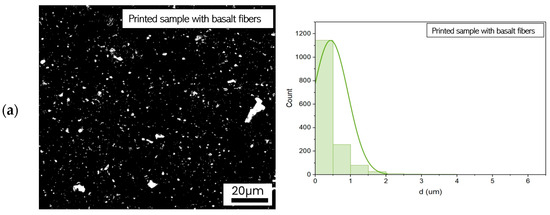

Figure 18.
Pore size distribution in printed samples: (a) B1/SL/B05 (4.14 MPa), (b) B1/FA/M05 (4.08 MPa), (c) B1/FA (2.68 MPa).
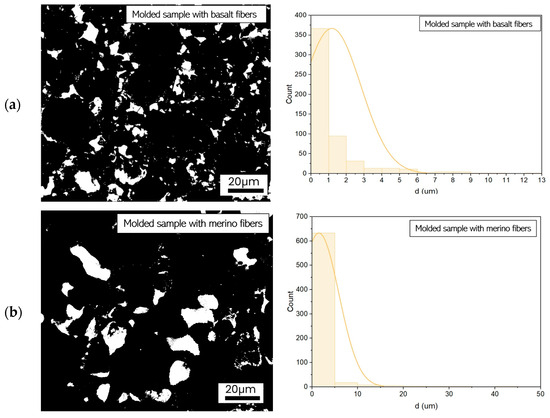

Figure 19.
Pore size distribution in molded samples: (a) B1/SL/B05 (3.21 MPa), (b) B1/FA/M05 (2.80 MPa), (c) B1/FA (1.72 MPa).
In molded samples, the pore distribution differs substantially, with a notable increase in both pore size and heterogeneity, which negatively impacts mechanical properties. The molded sample containing basalt fibers (B1/SL/B05) exhibits significantly larger pores, some exceeding 10 µm, as shown in Figure 19a. This higher porosity may be responsible for its reduced compressive strength of 3.21 MPa compared to its printed counterpart. The molded sample reinforced with merino fibers (B1/FA/M05) presents an even broader pore size distribution, with pores exceeding 20 µm. This increased porosity likely contributes to a further reduction in compressive strength, reaching 2.80 MPa. The most pronounced porosity is observed in the molded sample without fibers (B1/FA), where numerous macropores larger than 10 µm are evident. Such an irregular and porous structure leads to the lowest recorded compressive strength of 1.72 MPa.
The correlation between porosity and mechanical properties suggests that printed samples consistently exhibit lower porosity and smaller pore sizes compared to molded samples, which may contribute to their superior mechanical performance. The refined pore structure in printed samples, particularly those reinforced with basalt and merino fibers, likely enhances material densification and structural integrity. This may explain the relatively high flexural strength observed in these samples. In contrast, the larger and more irregularly distributed pores in molded samples create structural weaknesses, reducing their mechanical performance. Additionally, the presence of fibers, especially basalt, appears to contribute to a more controlled pore distribution, further supporting the material’s strength. Conversely, the absence of fibers leads to increased porosity, which may adversely affect mechanical integrity. These findings underscore the advantages of additive manufacturing in controlling porosity and optimizing the mechanical properties of fiber-reinforced cementitious materials.
4. Conclusions
This study investigated the impact of dispersed fiber reinforcement on the properties and printability of 3D-printed foamed concrete. The findings indicate that a higher fiber content (1 wt.%) significantly impeded the printing process, with specific fibers, such as polypropylene, rendering extrusion entirely unfeasible due to nozzle clogging. Reducing the fiber content to 0.5 wt.% improved material flowability and minimized printing defects. Additionally, mixtures incorporating coal slag with stiff fibers, such as basalt and glass, achieved the highest flexural strength, while merino wool fibers enhanced the mechanical performance of fly ash-based mixtures.
This study also revealed that printed samples exhibited higher flexural strength compared to molded specimens, primarily due to microstructural modifications introduced by the 3D printing process. However, fiber selection and printing conditions significantly influenced performance, emphasizing the importance of optimizing fiber type, concentration, and processing parameters. Natural fibers, such as coconut and wool, contributed to crack-bridging effects, further enhancing mechanical properties.
Water absorption varied significantly depending on the fiber type and its interaction with the cementitious matrix. Natural fibers, including merino wool and coconut, exhibited higher water absorption due to their hydrophilic nature and capillary action, particularly in 3D-printed samples with an open-pore structure. In contrast, hydrophobic fibers, such as polypropylene, basalt, and glass, contributed to reduced water retention, which may affect the material’s durability and potential applications.
Moreover, the correlation between porosity and mechanical properties suggests that printed samples consistently exhibit lower porosity and smaller pore sizes compared to molded samples, which may contribute to their superior mechanical performance. The refined pore structure in printed samples, particularly those reinforced with specific fibers, likely enhances material densification and structural integrity. This characteristic may explain the relatively high flexural strength observed in these samples. Additionally, the addition of foam in a 1:1 ratio is easier to control during the printing process, allowing for a more uniform pore structure and improved mechanical performance. However, in molded samples, this foam ratio is excessively high, leading to increased porosity and reduced mechanical strength. The presence of larger and more irregularly distributed pores in molded samples creates structural weaknesses, further diminishing their overall performance.
Future research will focus on hybrid fiber reinforcement strategies, combining flexible natural fibers with rigid synthetic fibers to improve mechanical performance. Additionally, the thermal resistance of the tested materials will be assessed to better understand their suitability for construction applications.
Author Contributions
Conceptualization, M.R., K.K. and M.H.; methodology, M.R.; software, A.H.; validation, M.R., M.M. and M.H.; formal analysis, M.R. and M.H.; investigation, M.R. and M.M.; resources, M.R. and M.H.; writing—original draft preparation, M.R.; writing—review and editing, M.R., K.K. and M.H.; visualization, M.M. and A.H.; supervision, K.K. and M.H.; project administration, M.R. and M.H.; funding acquisition, M.R. and M.H. All authors have read and agreed to the published version of the manuscript.
Funding
This research has been supported by the Ministry of Education and Science within the program “Implementation Doctorate”, DWD/6/0528/2022.
Institutional Review Board Statement
Not applicable.
Informed Consent Statement
Not applicable.
Data Availability Statement
The original contributions presented in this study are included in the article. Further inquiries can be directed to the corresponding author.
Conflicts of Interest
The authors declare no conflicts of interest.
References
- Tu, H.; Wei, Z.; Bahrami, A.; Kahla, N.B.; Ahmad, A.; Özkılıç, Y.O. Recent advancements and future trends in 3D concrete printing using waste materials. Dev. Built Environ. 2023, 16, 100187. [Google Scholar] [CrossRef]
- Rahman, M.; Rawat, S.; Yang RCh Mahil, A.; Zhang, Y.X. A comprehensive review on fresh and rheological properties of 3D printable cementitious composites. J. Build. Eng. 2024, 91, 109719. [Google Scholar] [CrossRef]
- Khan, M.; Shakeel, M.; Khan, K.; Akbar, S.; Khan, A. A Review on Fiber-Reinforced Foam Concrete. Eng. Proc. 2022, 22, 13. [Google Scholar] [CrossRef]
- Amran, M.; Fediuk, R.; Vatin, N.; Huei Lee, Y.; Murali, G.; Ozbakkaloglu, T.; Klyuev, S.; Alabduljabber, H. Fibre-Reinforced Foamed Concretes: A Review. Materials 2020, 13, 4323. [Google Scholar] [CrossRef]
- Szechyńska-Hebda, M.; Hebda, M.; Doğan-Sağlamtimur, N.; Lin, W.-T. Let’s Print an Ecology in 3D (and 4D). Materials 2024, 17, 2194. [Google Scholar] [CrossRef]
- Panda, B.; Suvash, P.; Tan, M.J. Anisotropic mechanical performance of 3D printed fiber reinforced sustainable construction material. Mater. Lett. 2017, 209, 146–149. [Google Scholar] [CrossRef]
- Zhang, P.; Lu, X. Study on Bending Strength of Cementitious Composites Based on Fiber Alignment. J. Phys. Conf. Ser. 2021, 2011, 12033. [Google Scholar] [CrossRef]
- Pham, L.; Tran, P.; Sanjayan, J. Steel fibres reinforced 3D printed concrete: Influence of fibre sizes on mechanical performance. Constr. Build. Mater. 2020, 250, 118785. [Google Scholar] [CrossRef]
- Ma, G.; Li, Z.; Wang, L.; Wang, F.; Sanjayan, J. Mechanical anisotropy of aligned fiber reinforced composite for extrusion-based 3D printing. Constr. Build. Mater. 2019, 202, 770–783. [Google Scholar] [CrossRef]
- Scheurer, M.; Quenzel, P.; Nölke, P.; Reuter-Schniete, J.; Gries, T. Investigating the feasibility of using carbon fiber tapes as reinforcement for 3D concrete printing. Civil Engineering Design. 2021, 3, 136–142. [Google Scholar] [CrossRef]
- Chu, S.H.; Li, L.G.; Kwan, A.K.H. Development of extrudable high strength fiber reinforced concrete incorporating nano calcium carbonate. Addit. Manuf. 2021, 37, 101617. [Google Scholar] [CrossRef]
- Li, L.G.; Xiao, B.-F.; Cheng, C.-M.; Xie, H.-Z.; Kwan, A.K.H. Adding Glass Fibers to 3D Printable Mortar: Effects on Printability and Material Anisotropy. Buildings 2023, 13, 2295. [Google Scholar] [CrossRef]
- Bong, S.H.; Nematollahi, B.; Arunothayan, A.; Xia, M.; Sanjayan, J. Effect of Wollastonite Micro-Fiber Addition on Properties of 3D-Printable ‘Just-Add-Water’ Geopolymers. In Second RILEM International Conference on Concrete and Digital Fabrication: Digital Concrete 2020; Springer: Cham, Switzerland, 2020. [Google Scholar] [CrossRef]
- Ramezani, A.; Modaresi, S.; Dashti, P.; GivKashi, M.R.; Moodi, F.; Ramezanianpour, A.A. Effects of Different Types of Fibers on Fresh and Hardened Properties of Cement and Geopolymer-Based 3D Printed Mixtures: A Review. Buildings 2023, 13, 945. [Google Scholar] [CrossRef]
- Jiang, Q.; Liu, Q.; Wu, S.; Zheng, H.; Sun, W. Modification effect of nanosilica and polypropylene fiber for extrusion-based 3D printing concrete: Printability and mechanical anisotropy. Addit. Manuf. 2022, 56, 102944. [Google Scholar] [CrossRef]
- Liu, B.; Liu, X.; Li, G.; Geng, S.; Li, Z.; Weng, Y.; Qian, Y. Study on anisotropy of 3D printing PVA fiber reinforced concrete using destructive and non-destructive testing methods. Case Stud. Constr. Mater. 2022, 17, e01519. [Google Scholar] [CrossRef]
- Lyu, Q.; Dai, P.; Chen, A. Mechanical strengths and optical properties of translucent concrete manufactured by mortar-extrusion 3D printing with polymethyl methacrylate (PMMA) fibers. Compos. Part B Eng. 2023, 268, 111079. [Google Scholar] [CrossRef]
- Sun, J.; Wu, Q.; Wang, Y.; Liu, H.; Zhao, H.; Cui, W.; Zhang, W.; Wang, X. 3D printed concrete incorporating waste rubber: Anisotropic properties and environmental impact analysis. J. Mater. Res. Technol. 2024, 33, 2773–2784. [Google Scholar] [CrossRef]
- Korniejenko, K.; Łach, M.; Chou, S.-Y.; Lin, W.-T.; Cheng, A.; Hebdowska-Krupa, M.; Gądek, S.; Mikuła, J. Mechanical Properties of Short Fiber-Reinforced Geopolymers Made by Casted and 3D Printing Methods: A Comparative Study. Materials 2020, 13, 579. [Google Scholar] [CrossRef] [PubMed]
- Tarhan, Y.; Perrot, A. Reinforcement of 3D printable earth-based mortar with natural textile material. Mater. Today Proc. 2023; in press. [Google Scholar] [CrossRef]
- Varela, H.; Pimentel Tinoco, M.; Mendoza Reales, O.A.; Dias Toledo Filho, R.; Barluenga, G. Sisal fiber reinforced mortar for 3D printing applications in construction. Procedia Struct. Integr. 2024, 64, 1427–1434. [Google Scholar] [CrossRef]
- Zhang, Y.; Zhu, Y.; Ren, Q.; He, B.; Jiang, Z.; Tittelboom, K.V.; De Schutter, G. Comparison of printability and mechanical properties of rigid and flexible fiber-reinforced 3D printed cement-based materials. Constr. Build. Mater. 2023, 400, 132750. [Google Scholar] [CrossRef]
- Warsi, S.B.F.; Panda, B.; Biswas, P. Exploring fibre addition methods and mechanical properties of fibre-reinforced 3D printed concrete: A review. Dev. Built Environ. 2023, 16, 100295. [Google Scholar] [CrossRef]
- Shakor, P.; Nejadi, S.; Sutjipto, S.; Paul, G.; Gowripalan, N. Effects of deposition velocity in the presence/absence of E6-glass fibre on extrusion-based 3D printed mortar. Addit. Manuf. 2020, 32, 101069. [Google Scholar] [CrossRef]
- Zhao, Y.; Wu, X.; Zhu, L.; Yang, Z.; Wang, Y.; Xi, X. The Influence of Polypropylene Fiber on the Working Performance and Mechanical Anisotropy of 3D Printing Concrete. J. Adv. Concr. Technol. 2021, 19, 1264–1274. [Google Scholar] [CrossRef]
- Rudziewicz, M.; Maroszek, M.; Góra, M.; Dziura, P.; Mróz, K.; Hager, I.; Hebda, M. Feasibility Review of Aerated Materials Application in 3D Concrete Printing. Materials 2023, 16, 6032. [Google Scholar] [CrossRef]
- Markin, V.; Ivanova, I.; Fataei, S.; Reißig, S.; Mechtcherine, V. Investigation on Structural Build-Up of 3D Printable Foam Concrete. In Second RILEM International Conference on Concrete and Digital Fabrication: Digital Concrete 2020; RILEM Book Series; Springer: Berlin/Heidelberg, Germany, 2020; pp. 301–311. [Google Scholar]
- Ma, X.; Li, C.; Chen, H.; Wei, Y.; Weng, Y.; Li, S.; Hojiboev, D. Research on the Improving Performance of Foam Concrete Applied to the Filling of Natural Gas Pipeline Cross-River Tunnel. Materials 2022, 15, 7461. [Google Scholar] [CrossRef]
- Haller, T.; Beuntner, N.; Gutsch, H.; Thienel, K.C. Challenges on pumping infra-lightweight concrete based on highly porous aggregates. J. Build. Eng. 2023, 65, 105761. [Google Scholar] [CrossRef]
- Falliano, D.; Parmigiani, S.; Suarez-Riera, D.; Ferro, G.; Restuccia, L. Stability, flexural behavior and compressive strength of ultra-lightweight fiber-reinforced foamed concrete with dry density lower than 100 kg/m3. J. Build. Eng. 2022, 51, 104329. [Google Scholar] [CrossRef]
- Selija, K.; Gandhi, I.S.R. Comprehensive investigation into the effect of the newly developed natural foaming agents and water to solids ratio on foam concrete behaviour. J. Build. Eng. 2022, 58, 105042. [Google Scholar] [CrossRef]
- Liu, C.; Chen, Y.; Xiong, Y.; Jia, L.; Ma LWang, X.; Chen, C.; Banthia, N.; Zhang, Y. Influence of HPMC and SF on buildability of 3D printing foam concrete: From water state and flocculation point of view. Compos. Part B Eng. 2022, 242, 110075. [Google Scholar] [CrossRef]
- Pasupathy, K.; Ramakrishnan, S.; Sanjayan, J. Enhancing the properties of foam concrete 3D printing using porous aggregates. Cem. Concr. Compos. 2022, 133, 104687. [Google Scholar] [CrossRef]
- Li, S.; Chen, B.; Chen, Z.; Gao, Z. Performance assessment of basalt fiber reinforced foamed concrete under freeze-thaw conditions using advanced acoustic emission parameters. Constr. Build. Mater. 2024, 440, 137444. [Google Scholar] [CrossRef]
- Lei, Z.; Li, Q.; Zhou, Y.; Yin, B. Mechanical performance and reinforcing mechanisms of foamed concrete strengthened by carbon fibers. J. Build. Eng. 2024, 97, 110765. [Google Scholar] [CrossRef]
- Wang, X.; Jin, Y.; Ma, Q.; Li, X. Performance and mechanism analysis of natural fiber-reinforced foamed concreto. Case Stud. Constr. Mater. 2024, 21, e03476. [Google Scholar] [CrossRef]
- Awang, H.; Mydin, M.A.O.; Roslan, A.F. Effects of fibre on drying shrinkage, compressive and flexural strength of lightweight foamed concrete. Adv. Mat. Res. 2012, 587, 144–149. [Google Scholar] [CrossRef]
- Zheng, G.; Shi, Y.; Li, Q.; Yang, Q.; Lu, X.; Zhang, X.; Cheng, X. Study on Properties of Fiber Reinforced Foam Concret 7 th International Conference on the Durability of Concrete Structures. Available online: https://docs.lib.purdue.edu/cgi/viewcontent.cgi?article=1677&context=icdcs (accessed on 2 January 2025).
- Li, L.; Wang, W.; Wang, Y.; Li, D.; Zhuang, M.L. Experimental study on pore structure characteristics and thermal conductivity of fibers reinforced foamed concrete. PLoS ONE 2023, 18, 287690. [Google Scholar] [CrossRef]
- Bayraktar, O.Y.; Kaplan, G.; Gencel, O.; Benli, A.; Sutcu, M. Physico-mechanical, durability and thermal properties of basalt fiber reinforced foamed concrete containing waste marble powder and slag. Constr. Build. Mater. 2021, 288, 123128. [Google Scholar] [CrossRef]
- Gencel, O.; Nodehi, M.; Bayraktar, O.Y.; Kaplan, G.; Benli, A.; Gholampour, A.; Ozbakkaloglu, T. Basalt fiber-reinforced foam concrete containing silica fume: An experimental study. Constr. Build. Mater. 2022, 326, 126861. [Google Scholar] [CrossRef]
- Gavi, K.; Olusegun, J. The Future of Construction: Leveraging Automation and AI Integration for Smarter, More Efficient Building Practices. 2024. Available online: https://www.researchgate.net/publication/386507818_The_Future_of_Construction_Leveraging_Automation_and_AI_Integration_for_Smarter_More_Efficient_Building_Practices (accessed on 2 January 2025).
- Rathod, D.; Raichura, U.; Pitroda, J.; Rathod, J.; Patel, R. Analyzing on-Site and off-Site Automation in the Construction Industry: A Comprehensive Overview. Indian J. Nat. Prod. 2024, 14, 68880–68888. [Google Scholar]
- Liu, Y.; Alias, A.H.; Haron, N.A.; Bakar, N.A.; Wang, H. Robotics in the Construction Sector: Trends, Advances, and Challenges. J. Intell. Robot. Syst 2024, 110, 72. [Google Scholar] [CrossRef]
- Akanbi, L.A.; Oyedele, A.O.; Oyedele, L.O.; Salami, R.O. Deep learning model for Demolition Waste Prediction in a circular economy. J. Clean. Prod. 2020, 274, 122843. [Google Scholar] [CrossRef]
- Rane, N.; Choudhary, S.; Rane, J. A New Era of Automation in the Construction Industry: Implementing Leading-Edge Generative Artificial Intelligence, such as ChatGPT or Bard. SSRN Electron. J. 2024. [Google Scholar] [CrossRef]
- PN-EN 197-1:2012; Cement—Part 1: Composition, Specifications and Conformity Criteria for Common Cements. Polish Committee for Standardization: Warsaw, Poland, 2012.
- Kearsley, E.P.; Wainwright, P.J. The effect of high fly ash content on the compressive strength of foamed concrete. Cem. Concr. Res. 2001, 31, 105–112. [Google Scholar] [CrossRef]
- Available online: https://www.holcim.pl/sites/poland2/files/2024-03/karta-charakterystyki-dla-cementu-cem-iv-b-v-32-5-n-cem-iv-b-v-42-5-n-lh-cem-iv-b-v-42-5-n-lh-na.pdf (accessed on 28 December 2024).
- Rudziewicz, M.; Maroszek, M.; Hutyra, A.; Góra, M.; Rusin-Żurek, K.; Hebda, M. Influence of Foaming Agents and Stabilizers on Porosity in 3D Printed Foamed Concrete. Processes 2025, 13, 403. [Google Scholar] [CrossRef]
- PN-EN 1015-3:2000; Metody Badań Zapraw do Murów—Określenie Konsystencji Świeżej Zaprawy (za Pomocą Stolika Rozpływu). Polish Committee for Standardization: Warsaw, Poland, 2004.
- Maroszek, M.; Rudziewicz, M.; Hutyra, A.; Dziura, P.; Hebda, M. Evaluation of 3D Concrete Printing Extrusion Efficiency. Appl. Sci. 2024, 14, 11866. [Google Scholar] [CrossRef]
- EN 13892-2:2004; Bending and Compression Strength. BSI: London, UK, 2002.
- Xu, N.; Qian, Y. Effects of fiber volume fraction, fiber length, water-binder ratio, and nanoclay addition on the 3D printability of strain-hardening cementitious composites (SHCC). Cem. Concr. Compos. 2023, 139, 105066. [Google Scholar] [CrossRef]
- Rudziewicz, M.; Maroszek, M.; Setlak, K.; Góra, M.; Hebda, M. Optimization of Foams—Polypropylene Fiber-Reinforced Concrete Mixtures Dedicated for 3D Printing. Materials 2024, 17, 4106. [Google Scholar] [CrossRef]
- Marczyk, J.; Ziejewska, C.; Pławecka, K.; Bak, A.; Łach, M.; Korniejenko, K.; Hager, I.; Mikuła, J.; Lin, W.-T.; Hebda, M. Optimizing theL/S Ratio in Geopolymers for the Production of Large-Size Elementswith 3D Printing Technology. Materials 2022, 15, 3362. [Google Scholar] [CrossRef]
- Fantilli, A.P.; Sicardi, S.; Dotti, F. The Use of Wool as Fiber-Reinforcement in Cement-Based Mortar. Acad. J. Civ. Eng. 2015, 33, 341–346. [Google Scholar] [CrossRef]
- Sun, J.; Aslani, F.; Lu, J.; Wang, L.; Huang, Y.; Ma, G. Fibre-reinforced lightweight engineered cementitious composites for 3D concrete printing. Ceram. Int. 2021, 47, 27107–27121. [Google Scholar] [CrossRef]
- Boddepalli, U.; Gandhi, I.S.R.; Panda, B. Synergistic effect of fly ash and polyvinyl alcohol fibers in improving stability, rheology, and mechanical properties of 3D printable foam concrete. Constr. Build. Mater. 2024, 429, 136464. [Google Scholar] [CrossRef]
- Luo, S.; Jin, W.; Wu, W.; Zhang, K. Rheological and mechanical properties of polyformaldehyde fiber reinforced 3D-printed high-strength concrete with the addition of fly ash. J. Build. Eng. 2024, 98, 111387. [Google Scholar] [CrossRef]
- Sikora, P.; Techman, M.; Federowicz, K.; El-Khayatt, A.M.; Saudi, H.A.; Elrahman, M.A.; Hoffmann, M.; Stephan, D.; Chung, S.Y. Insight into the microstructural and durability characteristics of 3D printed concrete: Cast versus printed specimens. Case Stud. Constr. Mater. 2022, 17, e01320. [Google Scholar] [CrossRef]
- Mishra, L.; Basu, G. 8—Coconut fibre: Its structure, properties and applications. In Handbook of Natural Fibres, 2nd ed.; Kozłowski, R.M., Mackiewicz-Talarczyk, M., Eds.; Woodhead Publishing Series in Textiles; Woodhead Publishing: Sawston, UK, 2020; pp. 231–255. ISBN 9780128183984. [Google Scholar] [CrossRef]
- Erdogan, U.H.; Seki, Y.; Selli, F. 9—Wool fibres. In Handbook of Natural Fibres, 2nd ed.; Kozłowski, R.M., Mackiewicz-Talarczyk, M., Eds.; Woodhead Publishing Series in Textiles; Woodhead Publishing: Sawston, UK, 2020; pp. 257–278. ISBN 9780128183984. [Google Scholar] [CrossRef]
- Alyousef, R.; Alabduljabbar, H.; Mohammadhosseini, H.; Mohamed, A.; Siddika, A.; Alrshoudi, F.; Alaskar, A. Utilization of sheep wool as potential fibrous materials in the production of concrete composites. J. Build. Eng. 2020, 30, 101216. [Google Scholar] [CrossRef]
Disclaimer/Publisher’s Note: The statements, opinions and data contained in all publications are solely those of the individual author(s) and contributor(s) and not of MDPI and/or the editor(s). MDPI and/or the editor(s) disclaim responsibility for any injury to people or property resulting from any ideas, methods, instructions or products referred to in the content. |
© 2025 by the authors. Licensee MDPI, Basel, Switzerland. This article is an open access article distributed under the terms and conditions of the Creative Commons Attribution (CC BY) license (https://creativecommons.org/licenses/by/4.0/).